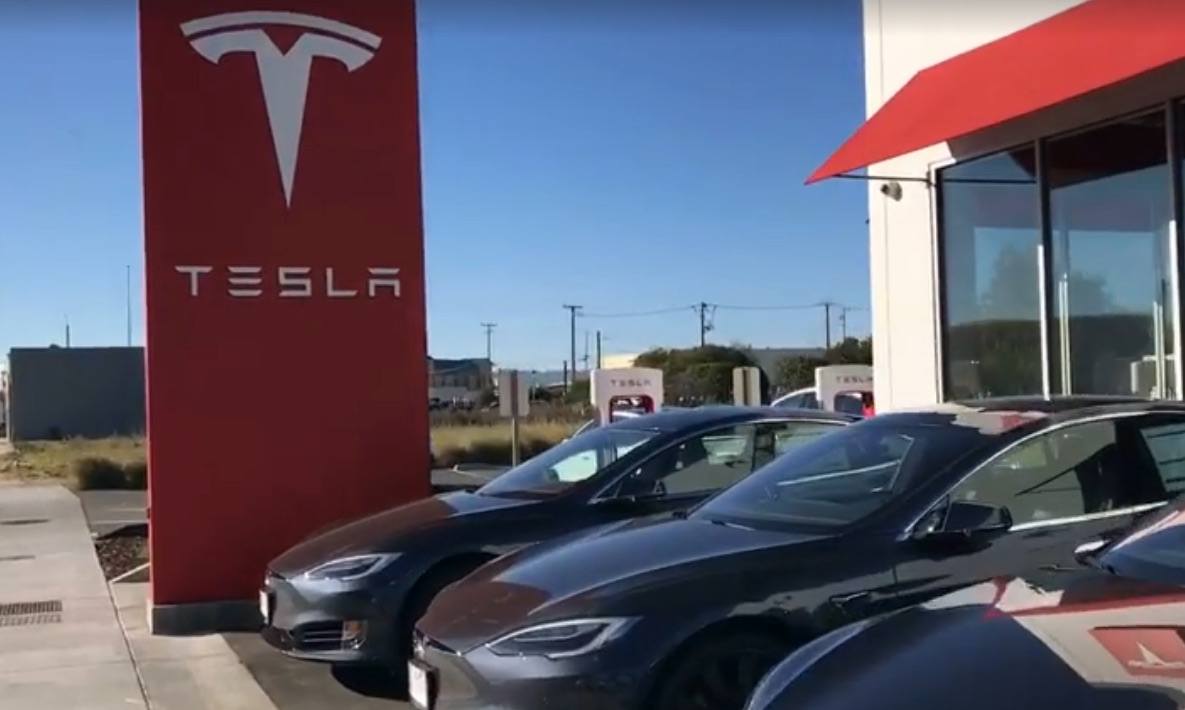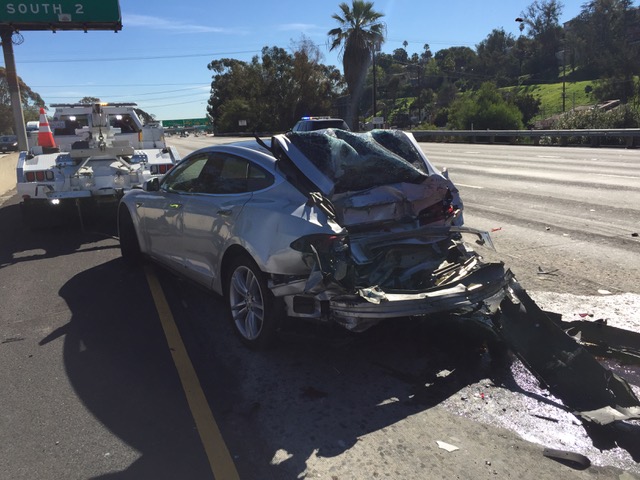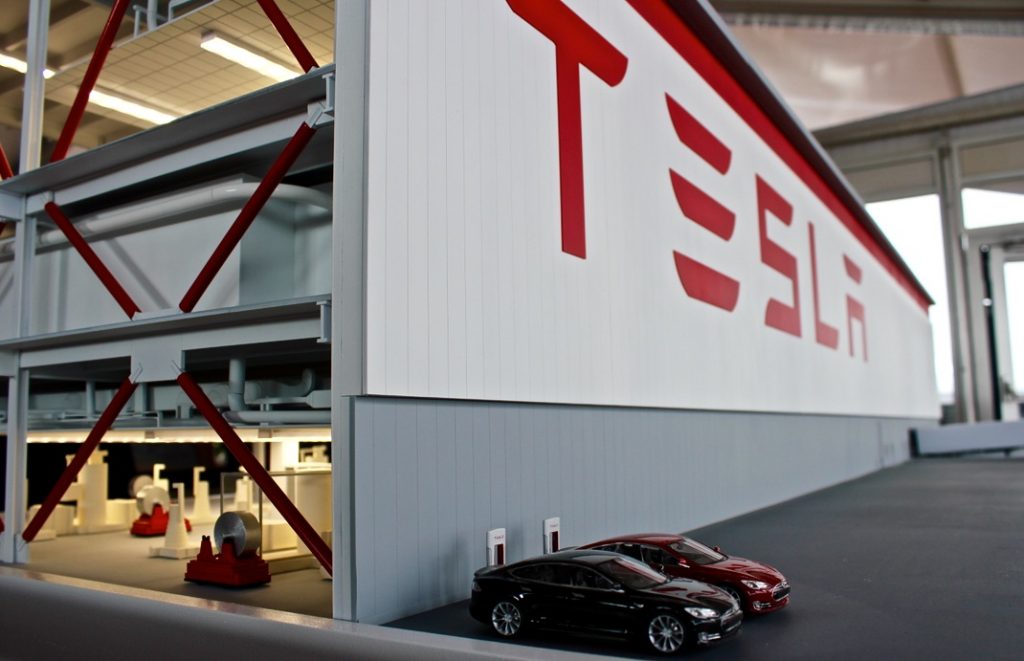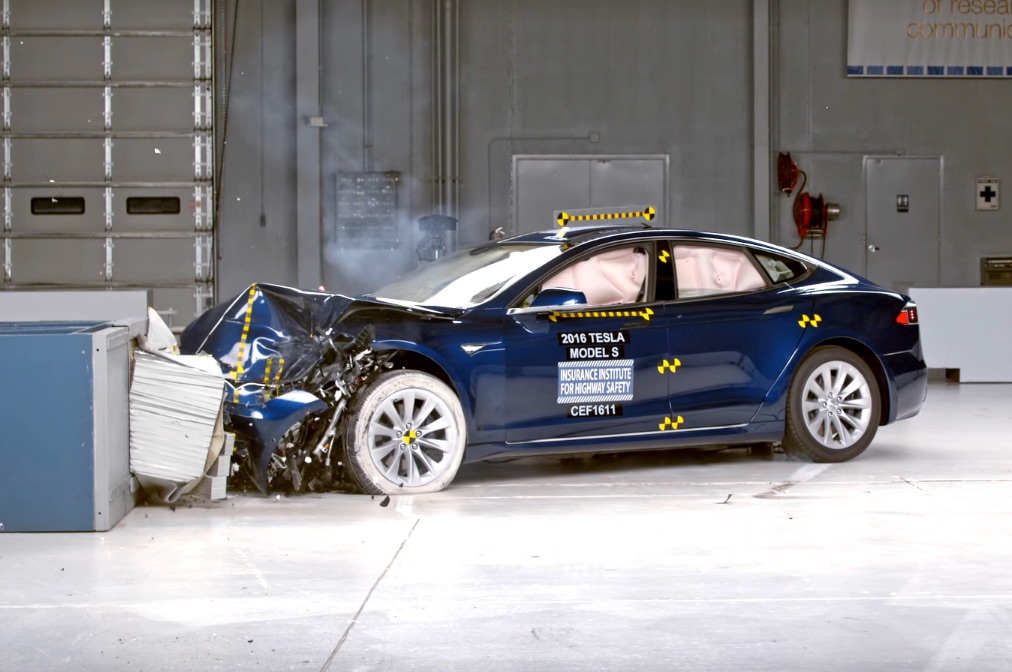News
Tesla top 5: Week in review, February 4

Tesla Model S real-world safety demonstrated after violent rear-end collision
A Reddit user recently posted photos of a Tesla Model S that had a rear-end collision with a Volvo truck. The post concurred with an Insurance Institute of Highway Safety crash test result for the Tesla Model S in which it earned only an “acceptable” rating on its rear crash test. To look at the Reddit photo, one might think that the Tesla Model S does quite well. With a curb weight of 4,647 pounds, the Model S has mass that helped it stand up to a 10-ton truck. The 1,200-lb. flat battery pack strapped to the frame likely was a positive factor, as it reinforces the structural integrity of the vehicle. The Reddit post’s author reported that the driver of the Model S walked away from the collision safe and believes the Tesla saved his life.
Welcome to Tesla, Inc.: We’re more than just electric cars
Tesla announced a corporate name change this week from “Tesla Motors” to “Tesla.” At the time of the company’s founding, the company was positioned as an alternative automobile company. Now, over a decade later, much has changed. With the revised moniker, Tesla confers a broader range of products and services, so that its market reach is much more extensive. Whether it is solar roof tiles, residential and commercial battery systems, or future endeavors such as semi-trucks, electric buses, ride sharing, and tunnel boring, the name Tesla speaks to the company’s overarching goals of clean energy efforts. Musk has repeated how his company will “create stunning solar roofs with seamlessly integrated battery storage, expand the electric vehicle product line to address all major segments, develop a self-driving capability that is 10X safer than manual via massive fleet learning, [and] enable your car to make money for you when you aren’t using it.” The name change now represents that social justice sustainability mission.
Tesla will release 4Q and ’16 full year financial result on February 22
Tesla has announced that on February 22, 2017, it will release Q4 2016 and full year 2016 financial results. First, Tesla will issue a brief advisory, which will include a link to the Q4 as well as a full year 2016 update letter. Each will be posted on the Tesla IR website. To accompany those data releases, the Tesla management will hold a live question and answer webcast that day, scheduled at this writing for 2:30 p.m. Pacific Time (5:30pm Eastern Time). Topics will include the company’s 2016 financial and business results and 2017+ outlook.
Tesla Model S crash test result misses top safety rating by IIHS
The Tesla Model S large luxury sedan earned good ratings in all Insurance Institute for Highway Safety (IIHS) “crashworthiness evaluations” except one: the challenging small overlap front crash test. In that evaluation, it earned just an acceptable rating. Even through Tesla had lengthened the side curtain airbags to improve small Model S overlap protection, it confronted testing issues when the safety belt allowed the dummy’s torso to move too far forward. The results indicated that duplicated real-world injuries would be “possible.” The ratings for the Model S apply to 2016 and 2017 cars built after October 2016. Tesla did make a production change on Jan. 23, 2017 to address the head-contact problem, so IIHS has said they will test the updated vehicle for small overlap protection.
Tesla Gigafactory in Lithuania reimagined within Minecraft game
Tesla’s mission to accelerate the world’s transition to sustainable energy requires production of lithium ion batteries to power their electric vehicles. The Tesla Gigafactory in Nevada began construction on November 4, 2014 and is expected to begin battery cell production by the end of this year. Even before that target production goal, however, Tesla is surveying European locations for a second Gigafactory. Lithuania would like to be chosen as that illustrious manufacturing site, so, to persuade Tesla it is the right fit, a team of Minecraft designers spent two days building a virtual model of Tesla’s Gigafactory. They envisioned Kruonis, Lithuania as the ideal spot for construction due to its “free economic zone, close to two international airports, within close radius of 1.3 million inhabitants.” Sustainable energy sources such as wind power were noted as a perk. Teams from several other European nations are also pitching their concepts to Tesla in the hopes that the next Gigafactory, with its associated job creation, will be in their neighborhoods.

News
Tesla starts showing how FSD will change lives in Europe
Local officials tested the system on narrow country roads and were impressed by FSD’s smooth, human-like driving, with some calling the service a game-changer for everyday life in areas that are far from urban centers.

Tesla has launched Europe’s first public shuttle service using Full Self-Driving (Supervised) in the rural Eifelkreis Bitburg-Prüm region of Germany, demonstrating how the technology can restore independence and mobility for people who struggle with limited transport options.
Local officials tested the system on narrow country roads and were impressed by FSD’s smooth, human-like driving, with some calling the service a game-changer for everyday life in areas that are far from urban centers.
Officials see real impact on rural residents
Arzfeld Mayor Johannes Kuhl and District Administrator Andreas Kruppert personally tested the Tesla shuttle service. This allowed them to see just how well FSD navigated winding lanes and rural roads confidently. Kruppert said, “Autonomous driving sounds like science fiction to many, but we simply see here that it works totally well in rural regions too.” Kuhl, for his part, also noted that FSD “feels like a very experienced driver.”
The pilot complements the area’s “Citizen Bus” program, which provides on-demand rides for elderly residents who can no longer drive themselves. Tesla Europe shared a video of a demonstration of the service, highlighting how FSD gives people their freedom back, even in places where public transport is not as prevalent.
What the Ministry for Economic Affairs and Transport says
Rhineland-Palatinate’s Minister Daniela Schmitt supported the project, praising the collaboration that made this “first of its kind in Europe” possible. As per the ministry, the rural rollout for the service shows FSD’s potential beyond major cities, and it delivers tangible benefits like grocery runs, doctor visits, and social connections for isolated residents.
“Reliable and flexible mobility is especially vital in rural areas. With the launch of a shuttle service using self-driving vehicles (FSD supervised) by Tesla in the Eifelkreis Bitburg-Prüm, an innovative pilot project is now getting underway that complements local community bus services. It is the first project of its kind in Europe.
“The result is a real gain for rural mobility: greater accessibility, more flexibility and tangible benefits for everyday life. A strong signal for innovation, cooperation and future-oriented mobility beyond urban centers,” the ministry wrote in a LinkedIn post.
News
Tesla China quietly posts Robotaxi-related job listing
Tesla China is currently seeking a Low Voltage Electrical Engineer to work on circuit board design for the company’s autonomous vehicles.

Tesla has posted a new job listing in Shanghai explicitly tied to its Robotaxi program, fueling speculation that the company is preparing to launch its dedicated autonomous ride-hailing service in China.
As noted in the listing, Tesla China is currently seeking a Low Voltage Electrical Engineer to work on circuit board design for the company’s autonomous vehicles.
Robotaxi-specific role
The listing, which was shared on social media platform X by industry watcher @tslaming, suggested that Tesla China is looking to fill the role urgently. The job listing itself specifically mentions that the person hired for the role will be working on the Low Voltage Hardware team, which would design the circuit boards that would serve as the nervous system of the Robotaxi.
Key tasks for the role, as indicated in the job listing, include collaboration with PCB layout, firmware, mechanical, program management, and validation teams, among other responsibilities. The role is based in Shanghai.
China Robotaxi launch
China represents a massive potential market for robotaxis, with its dense urban centers and supportive policies in select cities. Tesla has limited permission to roll out FSD in the country, though despite this, its vehicles have been hailed as among the best in the market when it comes to autonomous features. So far, at least, it appears that China supports Tesla’s FSD and Robotaxi rollout.
This was hinted at in November, when Tesla brought the Cybercab to the 8th China International Import Expo (CIIE) in Shanghai, marking the first time that the autonomous two-seater was brought to the Asia-Pacific region. The vehicle, despite not having a release date in China, received a significant amount of interest among the event’s attendees.
Elon Musk
Elon Musk and Tesla AI Director share insights after empty driver seat Robotaxi rides
The executives’ unoccupied tests hint at the rapid progress of Tesla’s unsupervised Robotaxi efforts.

Tesla CEO Elon Musk and AI Director Ashok Elluswamy celebrated Christmas Eve by sharing personal experiences with Robotaxi vehicles that had no safety monitor or occupant in the driver’s seat. Musk described the system’s “perfect driving” around Austin, while Elluswamy posted video from the back seat, calling it “an amazing experience.”
The executives’ unoccupied tests hint at the rapid progress of Tesla’s unsupervised Robotaxi efforts.
Elon and Ashok’s firsthand Robotaxi insights
Prior to Musk and the Tesla AI Director’s posts, sightings of unmanned Teslas navigating public roads were widely shared on social media. One such vehicle was spotted in Austin, Texas, which Elon Musk acknowleged by stating that “Testing is underway with no occupants in the car.”
Based on his Christmas Eve post, Musk seemed to have tested an unmanned Tesla himself. “A Tesla with no safety monitor in the car and me sitting in the passenger seat took me all around Austin on Sunday with perfect driving,” Musk wrote in his post.
Elluswamy responded with a 2-minute video showing himself in the rear of an unmanned Tesla. The video featured the vehicle’s empty front seats, as well as its smooth handling through real-world traffic. He captioned his video with the words, “It’s an amazing experience!”
Towards Unsupervised operations
During an xAI Hackathon earlier this month, Elon Musk mentioned that Tesla owed be removing Safety Monitors from its Robotaxis in Austin in just three weeks. “Unsupervised is pretty much solved at this point. So there will be Tesla Robotaxis operating in Austin with no one in them. Not even anyone in the passenger seat in about three weeks,” he said. Musk echoed similar estimates at the 2025 Annual Shareholder Meeting and the Q3 2025 earnings call.
Considering the insights that were posted Musk and Elluswamy, it does appear that Tesla is working hard towards operating its Robotaxis with no safety monitors. This is quite impressive considering that the service was launched just earlier this year.













